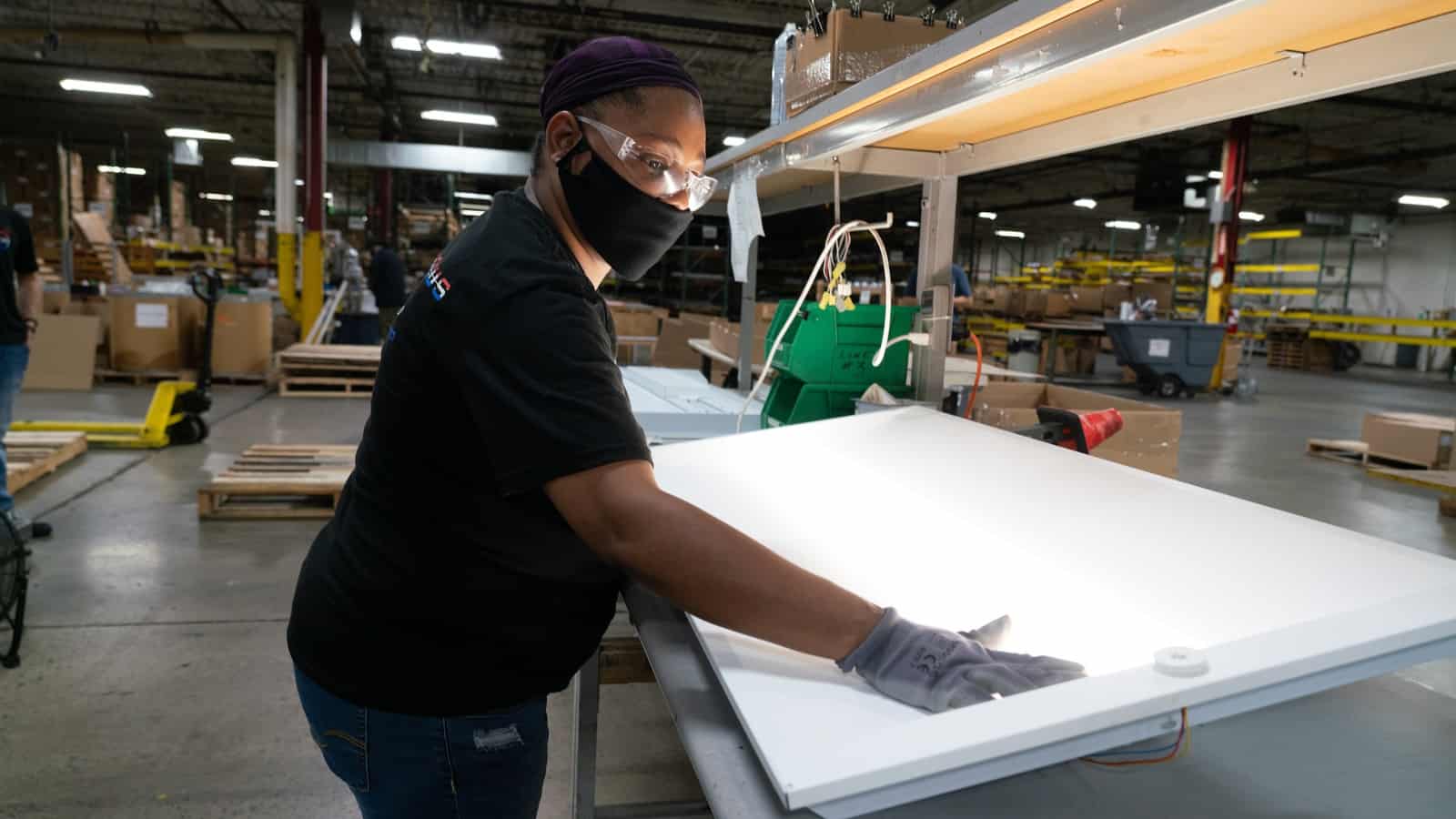Manufacturers Secure Priorities in Year-End Stimulus Legislation
Stoick: “We have been fully engaged with House and Senate leaders to keep this vital work going"
Washington, D.C. – Following passage of Senate amendment to H.R. 133 – United States Mexico Economic Partnership Act [Consolidated Appropriations Act, 2021], National Association of Manufacturers Vice President of Government Relations Jordan Stoick released the following statement:
“Manufacturers secured many of our top priorities in this important legislation, including numerous provisions the NAM first proposed in our ‘American Renewal Action Plan.’ The additional funds for the Paycheck Protection Program will provide a continued lifeline for small manufacturers. Furthermore, the resources for testing and vaccine distribution, as well as tax incentives for manufacturers that keep employees on payroll and invest in safety measures, will ensure America’s dedicated, essential manufacturing workers can continue their mission safely.
“Across the country, manufacturers are providing the vaccines, PPE and supplies needed to defeat COVID-19, so we have been fully engaged with House and Senate leaders to keep this vital work going. We have a difficult winter ahead, and this legislation will help save lives and livelihoods and keep manufacturers operating. As folks continue to roll up their sleeves and receive initial doses of the vaccine, we are also looking to the other priorities facing us in the new year—including historic investments in infrastructure, energy innovation and more—to ensure manufacturers can lead a full economic recovery and American renewal.”
-NAM-
The National Association of Manufacturers is the largest manufacturing association in the United States, representing small and large manufacturers in every industrial sector and in all 50 states. Manufacturing employs more than 12.2 million men and women, contributes $2.35 trillion to the U.S. economy annually and has the largest economic multiplier of any major sector and accounts for 62% of private-sector research and development. The NAM is the powerful voice of the manufacturing community and the leading advocate for a policy agenda that helps manufacturers compete in the global economy and create jobs across the United States. For more information about the NAM or to follow us on Twitter and Facebook, please visit www.nam.org.
Senators Introduce R&D Bill

A coming tax change would make it more expensive for manufacturers to undertake cutting-edge innovation—but a bipartisan Senate bill championed by the NAM is set to change that.
Where we are: Right now, if you’re running a business and you invest in research and development, you can immediately deduct 100% of those expenses in the year in which they are incurred. However, beginning in 2022, businesses will be forced to spread their R&D deductions out over a period of years, making it more expensive for manufacturers to undertake R&D. If this change were to go into effect, the United States would also be the only industrialized country in the world with this policy, harming our ability to compete internationally and invest for growth.
The cavalry arrives: The American Innovation and Jobs Act, a bipartisan bill introduced on Tuesday by Sens. Maggie Hassan (D-NH) and Todd Young (R-IN) would repeal the looming change, allowing businesses to continue to deduct their R&D expenses immediately. The bill would also make the R&D tax credit more accessible and more generous for small businesses.
Why it matters: Manufacturers perform the vast majority—nearly two-thirds—of private-sector R&D in the United States. That work not only helps finance important new projects and technological advancements, but it also helps to create well-paying jobs and power economic growth. That’s why the NAM has been leading the business community in getting bipartisan legislation introduced in the House and now in the Senate to stop this harmful change from going into effect.
A word from the NAM: “Research and development is the lifeblood of manufacturing,” said NAM Senior Director of Tax Policy David Eiselsberg. “It is what drives innovation, competitiveness, economic growth and the creation of high-paying jobs. This legislation will ensure that the tax code continues to support the ability of manufacturers to undertake R&D that will help promote economic and job growth.”
Why America Is a Great Location for Manufacturers

Manufacturing is a key driver of the American economy—but how does manufacturing in the United States stack up against the rest of the world?
Recently, The Manufacturing Institute and KPMG—a professional services firms providing innovative business solutions and audit, tax, and advisory services—released a new assessment of the cost of doing business in the manufacturing sector for the United States and 16 other major manufacturing exporting nations around the globe.
High costs, but high value: The study found that primary costs (compensation, property, utilities, taxes and interest rates) in the U.S. are on average 16% higher than in the other markets—yet the U.S. ranks fairly high on the list overall at #5.
- Another number bears that out: over the past decade, foreign direct investment in U.S. manufacturing has jumped from $569.3 billion in 2006 to a record $1,785.7 billion in 2019.
The benefits of tax reform: Tax reform made the U.S. a more desirable location for manufacturers, the study found. It compared how the U.S. would have ranked with its pre-reform corporate tax rate of 40% (the combined federal and state tax rate) instead of the post-reform corporate rate of 27%. With the old rate, the U.S. would have ranked only 11th.
The benefits of skilled workers: A major U.S. advantage is its supply of high-skilled workers. According to the study, the U.S. ranks at the top of the list for real value added per employee, along with Ireland and Switzerland. As manufacturing has become increasingly advanced, the need for sophisticated employees keeps growing.
While it’s true that American manufacturing requires more skilled workers, as The Manufacturing Institute has previously shown, the existing workforce is still a big draw due to its productivity.
The bottom line: The United States is an attractive location for manufacturers, despite relatively high costs, because of high worker productivity and the overall business environment.
The last word: “We need to continue to push the envelope of technological innovation and workforce development and recruitment in the manufacturing sector,” said Chad Moutray, chief economist for the National Association of Manufacturers and director of the Center for Manufacturing Research at The Manufacturing Institute. “These efforts will serve to strengthen the sector overall, but also help to maintain the nation’s global competitiveness.”
Manufacturing Leadership Awards Celebrate Innovative Manufacturers

Last night, the 2020 Manufacturing Leadership Awards Gala recognized some of the most innovative manufacturers in the country, at a virtual event hosted by the NAM’s Manufacturing Leadership Council. The MLC is a global business leadership network dedicated to preparing manufacturers for the opportunities and challenges posed by digitization, automation and technical advancement.
The winners: Presented to individuals and companies in 12 categories, including Sustainability Leadership and Artificial Intelligence and Analytics Leadership, the awards honor world-class manufacturing achievements. You can find the full list of honorees here.
The word from the MLC: “Creativity. Innovation. Excellence. Enlightened leadership. These are the qualities that drive the people of manufacturing to create a better future,” said MLC Co-Founder and Executive Director David Brousell in his opening remarks. “In doing so, they help themselves, their companies and our collective industry improve the quality of life for everyone. . . . All across this country, innovation in manufacturing is on the march.”
Manufacturer of the Year: The MLC honored two manufacturers with Manufacturer of the Year awards: agricultural chemical and seed company Corteva Agriscience, and Humtown Products, which was honored for its work to popularize 3D printing in sand cores. You can check out our profile of Humtown here.
Manufacturing Leader of the Year: This award went to Gerald Johnson, executive vice president, global manufacturing at GM, for his leadership in GM’s pivot to ventilator production in a partnership with Ventec Life Systems, code named Project V.
High Achiever Award Winners: The judges also presented high achiever awards to one winner in each category. Here’s the list:
- Lockheed Martin Corporation in the Artificial Intelligence and Advanced Analytics Leadership category for F-35 Augmented Reality Shop Floor Mobility
- Merck & Co., Inc., in the Collaborative Innovation Leadership category for Digital Fingerprinting
- Humtown Products in the Engineering and Production Technology Leadership category for Commercialization of 3D Printing in the Metal Casting Industry
- IBM in the Enterprise Integration Technology Leadership category for Migrating Supply Chain Quality Workload to Cloud
- Cooley Group in the Industrial Internet of Things Leadership category for Transforming Legacy Machinery into Smart Tech
- Hologic Inc. in the Operational Excellence category for Building a Culture of Operational Excellence
- Starkey Hearing Technologies in the Supply Chain Leadership category for Supply Chain Management Transformation
- The Boeing Company in the Sustainability Leadership category for Diverting Waste to Landfill While Upcycling Excess Airplane Carbon Fiber
- Nexteer Automotive in the Talent Management category for the Manufacturing Engineering Global Talent Management and Training Program
Government Mandates Will Not Lower Drug Costs
Timmons: “We should not import failed socialist price controls”
Washington, D.C. – National Association of Manufacturers President and CEO Jay Timmons released the following statement on the administration’s proposed rules to address drug pricing.
“We should not import failed socialist price controls, and we are surprised that President Trump and Secretary Azar would consider such actions. Our battle with COVID-19 shows just how vital pharmaceutical innovation is to our health and survival, and we cannot afford to limit companies’ ability to develop lifesaving treatments for this or future medical crises.
“Importing drugs from foreign countries that don’t guarantee the same standards for drugs made for the U.S. market poses a serious health risk, especially considering the counterfeiting challenges we already face.
“If enacted, tying any portion of our system to a foreign government-run health care system, through International Price Indexing or other means, is an abdication of free market principles.
“Manufacturers of all sectors are committed to lowering health care costs, and we call on the administration to commit to better market-based solutions that won’t hand over private-sector decisions to foreign governments, potentially impacting Medicare recipients and impacting our ability to help provide lifesaving medicines.”
-NAM-
The National Association of Manufacturers is the largest manufacturing association in the United States, representing small and large manufacturers in every industrial sector and in all 50 states. Manufacturing employs more than 11.7 million men and women, contributes $2.37 trillion to the U.S. economy annually and has the largest economic multiplier of any major sector and accounts for 63% of private-sector research and development. The NAM is the powerful voice of the manufacturing community and the leading advocate for a policy agenda that helps manufacturers compete in the global economy and create jobs across the United States. For more information about the NAM or to follow us on Twitter and Facebook, please visit www.nam.org.
The NAM Takes Aim at Counterfeiting

Business advocates and policymakers have a new tool for waging an aggressive effort against counterfeiting during the pandemic and beyond. The NAM has released a new report, “Countering Counterfeits,” which includes proposed solutions for Congress, the administration and the private sector to pursue.
The numbers: According to the NAM’s research, fake and counterfeit products cost the United States $131 billion and 325,000 jobs in 2019 alone.
The rising tide: The rise of e-commerce has caused an explosion in fake products, particularly from China. E-commerce has created a pipeline to consumers that counterfeiters can exploit while hiding their identities and evading oversight. Estimates now indicate that global trade in counterfeits exceeds $500 billion per year.
The plan: The NAM’s proposal pushes for a series of actions to help curb counterfeiting, including:
- Requiring e-commerce platforms to reduce the availability of counterfeits;
- Modernizing enforcement laws and tactics to keep pace with counterfeiting technology;
- Streamlining government coordination to tackle counterfeit items;
- Improving private-sector collaboration; and
- Empowering consumers to avoid counterfeit goods.
The NAM says: President and CEO Jay Timmons said in his introduction to the report, “The prevalence of counterfeits in the COVID-19 response has brought new urgency to this long-simmering issue. So the National Association of Manufacturers is leading the charge against fake and counterfeit goods, bringing together diverse stakeholders and driving innovative policy solutions to address these issues once and for all and to ensure the long-term success of our sector and the safety and security of the people who rely on our products.”
Report: U.S. Leads in Pharma Innovation, Thanks to Effective Policies

The new report from the ITI Foundation offers strategies to maintain U.S. strength, spur greater innovation and increase domestic production.
U.S. policies spur success: “America still leads in innovation and drug development, in large part due to effective life-science policies, including significant federal investment in life-sciences basic research, robust intellectual property (IP) protections, effective technology transfer policies, investment incentives, and, importantly, drug pricing policies that enable companies to invest in high-risk drug development.”
Recommendations for policymakers: The paper suggests U.S. policymakers should focus on four key areas:
- Maintaining U.S. strength in pricing, tech transfer and intellectual property—and avoiding oppressive drug price control schemes that damage competitiveness;
- Boosting innovation through investment and additional tax incentives that promote research and development;
- Increasing domestic production, including via tax credits and additional funding for key research institutions; and
- Combating foreign mercantilism by making sure that America’s trading partners pay their “fair share” for new drugs, treatments and other medical products.
Innovation in the time of COVID-19: At a time when U.S. pharmaceutical companies are central to the fight against a global pandemic, the ability to innovate successfully is of paramount importance. The U.S. House Committee on Energy and Commerce held a hearing on Tuesday that discussed the issue, titled “Pathway to a Vaccine: Efforts to Develop a Safe, Effective and Accessible COVID-19 Vaccine.”
The NAM says: “The research ecosystem we have in the United States supports a global leadership position of biopharmaceutical innovation,” said NAM Vice President of Infrastructure, Innovation and Human Resources Policy Robyn Boerstling. “Manufacturers are committed to building upon that innovation—but it’s clear that government-led pricing restrictions and importing bad health care policies used by our competitors is not the way forward.”
Related . . . The NAM has launched a new six-figure television and digital ad campaign aimed at potential rules to address drug pricing through International Price Indexing and drug importation.
NAM Launches Cyber Cover to Protect Manufacturers
AHT Insurance and underwriter Coalition partner with the NAM to deliver cybersecurity solution
Today, the National Association of Manufacturers announced the launch of NAM Cyber Cover, an exclusive cybersecurity and risk mitigation program for its member companies and organizations. This critically important and timely offering was developed in partnership with AHT Insurance and Coalition, which specializes in underwriting cyber and technology insurance.
“Modern manufacturers are deploying advanced technologies that are transforming what we make and how we make it. This rapid digitization and the workplace disruptions created by the COVID-19 pandemic have created new and unprecedented risks for our members,” said NAM President and CEO Jay Timmons. “Our partnership with AHT and Coalition will help protect our industry from cyberattacks and ensure we can continue to lead our economic recovery and renewal.”
According to a recent Wall Street Journal article, nearly two-thirds of manufacturers currently have no cyber insurance, and many manufacturers have no plans to invest in improved cybersecurity measures or data protection efforts. Recognizing the significant threat cyber vulnerabilities pose to its diverse membership, the NAM led the creation of Cyber Cover.
“The inimitable exposures manufacturers face, coupled with an unrelenting target on the industry, necessitates a pivot in how cyber programs are structured,” said AHT President and CEO David Schaefer. “We look forward to helping NAM members make that pivot to manage risks up front and protect themselves against cyberattacks.”
NAM Cyber Cover offers full support for responding to and recovering from potential risks and cyberattacks, differentiating it from traditional, standalone insurance.
“Manufacturers are more reliant on technology than ever before and more in need of a solution to survive catastrophic security failures and data breaches,” said Coalition Founder and CEO Joshua Motta. “We’re proud to partner with the NAM and AHT to revolutionize the way manufacturers mitigate cyber risk, providing security tools to prevent incidents and incident response support to mitigate losses, together with the safety of insurance.”
To learn more about NAM Cyber Cover, visit www.namcybercover.org
-NAM-
The National Association of Manufacturers is the largest manufacturing association in the United States, representing small and large manufacturers in every industrial sector and in all 50 states. Manufacturing employs more than 11.7 million men and women, contributes $2.37 trillion to the U.S. economy annually and has the largest economic multiplier of any major sector and accounts for 63% of private-sector research and development. The NAM is the powerful voice of the manufacturing community and the leading advocate for a policy agenda that helps manufacturers compete in the global economy and create jobs across the United States. For more information about the Manufacturers or to follow us on Twitter and Facebook, please visit www.nam.org.
–About AHT Insurance–
AHT Insurance is a brokerage and consulting firm offering property and casualty, employee benefits, retirement, personal and international services for a wide range of industries—notably receiving national recognition for its practices in areas including technology, manufacturing, government contracting and nonprofits. https://www.ahtins.com
–About Coalition–
Coalition combines comprehensive insurance and free cybersecurity tools to help businesses manage and mitigate cyber risk. Backed by A+/A rated insurers Swiss Re Corporate Solutions and Argo Group, Coalition provides companies with up to $10 million of cyber and technology insurance coverage in all 50 states and the District of Columbia. https://www.coalitioninc.com
NAM Releases Agenda to Strengthen Manufacturing Supply Chain
Launches Seven-Figure National Advertising Campaign to Bolster Business in America
Washington, D.C. – The National Association of Manufacturers has released a detailed agenda of supply chain policy recommendations to help policymakers as Congress and the administration look at ways to boost long-term economic growth. Manufacturers are also launching a seven-figure national advertising campaign on the importance of U.S. supply chains in the wake of COVID-19. The national television and digital advertising campaign urges leaders to make smart policy decisions that incentivize job creation and investment in America, without closing off critical global supply chains. Such a constructive approach will enable manufacturers to lead America’s recovery and renewal while continuing to produce the vital supplies, medicines and essential products on which Americans’ health and safety depends.
The policies that we are proposing will allow manufacturers to lead our economic recovery by strengthening supply chains and accelerating onshoring, through incentives for creating the next job or investing the next dollar right here in America. We also cannot close off access to critical components or resources that our lifesaving and life-changing products require, said NAM President and CEO Jay Timmons. Manufacturers are working around the clock to create the protective equipment, cleaning supplies, medicines and other essential products in the wake of COVID-19, and we need the right policies so we can make even more here at home and lead a truly historic American renewal.
In April, the NAM released its “American Renewal Action Plan,” which provides a comprehensive list of policy recommendations to guide the country through the stages of response, recovery and renewal.
More information on the campaign can be found at www.nam.org/recovery.
-NAM-
The National Association of Manufacturers is the largest manufacturing association in the United States, representing small and large manufacturers in every industrial sector and in all 50 states. Manufacturing employs nearly 11.5 million men and women, contributes $2.38 trillion to the U.S. economy annually, has the largest economic multiplier of any major sector and accounts for 63% of private-sector research and development. The NAM is the powerful voice of the manufacturing community and the leading advocate for a policy agenda that helps manufacturers compete in the global economy and create jobs across the United States. For more information about the Manufacturers or to follow us on Shopfloor, Twitter and Facebook, please visit www.nam.org
NAM’s Timmons Named to COVID-19 Great American Economic Revival Industry Groups
Timmons: Manufacturers Will Drive Next Phase of American Renewal
Washington, D.C. – National Association of Manufacturers President and CEO Jay Timmons released the following statement on the NAM being included in President Trump’s Great American Economic Revival Industry Groups.
“Throughout this crisis, manufacturers have been leading the way. Much of the sector has been fully operational, making critical personal protective equipment, medical supplies and ventilators, in addition to producing food and household essentials. Manufacturers have many examples of safe and healthy practices to share.
“Throughout the past month, the NAM has provided the White House, FEMA, the Coronavirus Task Force, DHS and other agencies with our legislative solutions for economic stabilization and future growth, as well as a database of available PPE supply and connecting the supply chain with OEMs.
“Over the past three years, manufacturers have produced impressive gains in investment, job creation and wage growth here in the United States. As the nation prepares to move from relief to recovery and bringing our $22 trillion economy out of its ‘induced coma,’ I look forward to working with the Great American Economic Revival Industry Groups, including the 44 NAM member companies that were also named, to drive this next phase of American renewal, while putting the health and well-being of the American people first. Ultimately, manufacturers, the backbone of this economy, want to be able to invest, grow and hire—right where we left off.”
-NAM-
The National Association of Manufacturers is the largest manufacturing association in the United States, representing small and large manufacturers in every industrial sector and in all 50 states. Manufacturing employs more than 12.8 million men and women, contributes $2.37 trillion to the U.S. economy annually and has the largest economic multiplier of any major sector and accounts for 63% of private-sector research and development. The NAM is the powerful voice of the manufacturing community and the leading advocate for a policy agenda that helps manufacturers compete in the global economy and create jobs across the United States. For more information about the Manufacturers or to follow us on Twitter and Facebook, please visit www.nam.org.